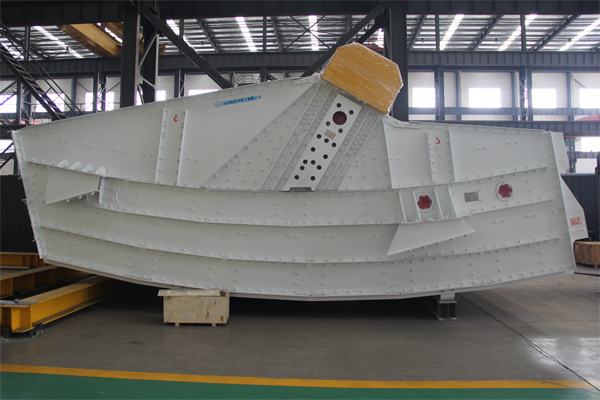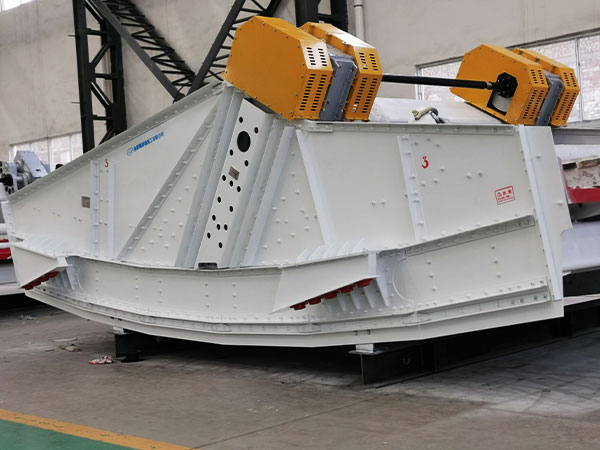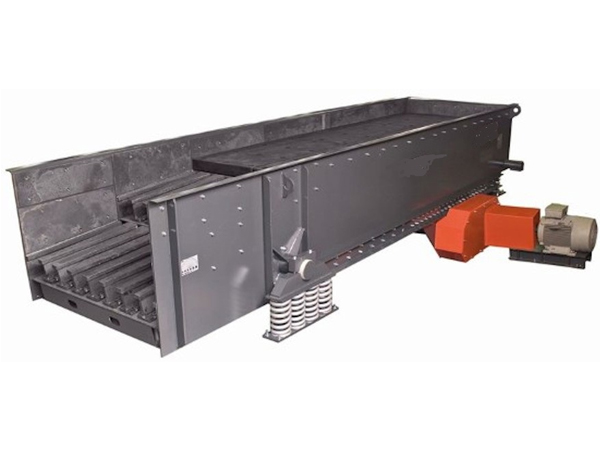How to adjust the vibration amplitude of vibrating screen
Vibration amplitude adjustment of vibrating screen




The design of a vibrating screen is a complex and meticulous process that requires comprehensive consideration of multiple aspects to ensure the performance, efficiency and reliability of the equipment.

Clear design goals: Determine design goals such as screening efficiency, processing capacity, wear resistance, etc. based on usage scenarios, material characteristics, and production capacity requirements.
Safety: Ensure the safety of the equipment during operation and maintenance, including setting emergency stop buttons, protective covers, and safety signs.
Easy to maintain: Provide sufficient maintenance channels and space for maintenance personnel to approach key components of the equipment for inspection and maintenance.

Screen frame
Material selection: Constructed with materials with high strength and rigidity, such as steel plates, to support the weight of the entire screening system and the forces generated during operation.
Design points: Consider stress distribution, welding quality, and overall stability to ensure that the screen frame can withstand large vibration forces.
Screen mesh
Material selection: Select appropriate screen mesh materials according to material characteristics and screening requirements, such as high manganese steel with good wear resistance or corrosion-resistant 316 stainless steel.
Support structure: Ensure uniform tensioning of the screen mesh to obtain ideal screening effect. The design of the support structure should facilitate the installation, adjustment and replacement of the screen, while reducing the risk of material blockage and screen damage.
Vibrator
Type selection: Select a suitable vibrator according to the vibration mode and requirements of the vibrating screen, such as an eccentric block vibrator driven by a motor.
Performance matching: Ensure that the performance of the vibrator matches the requirements of the screening system, including the setting of parameters such as vibration frequency and amplitude.
Inlet and outlet
Position design: Determine the location of the inlet and outlet according to the process flow and site conditions to ensure that the material can smoothly enter and leave the screening system.
Sealing: The inlet and outlet should have good sealing to prevent material leakage and dust flying.
Support device
Function: The support device is an auxiliary component of the vibrating screen, which can ensure the smooth operation of the vibrating screen and reduce the noise of the vibrating screen.
Design points: Use elastic elements (such as springs or rubber pads) to isolate the vibration force and reduce the impact on the foundation and the surrounding environment.

Vibration frequency
Selection basis: Determine the appropriate vibration frequency based on material characteristics, screen hole size and production capacity requirements. Too high a vibration frequency may lead to incomplete separation of materials, while too low a vibration frequency may reduce the screening efficiency.
Amplitude
Key points of control: Appropriate amplitude can improve screening efficiency, but too large an amplitude may cause the material to pass through the sieve holes prematurely, reducing the screening accuracy. Therefore, the amplitude needs to be precisely controlled to ensure the screening effect.
Vibration direction angle
Adjustment effect: By adjusting the vibration direction angle (i.e. the angle between the direction of the vibration force and the horizontal plane), the movement trajectory of the material on the screen surface can be changed to optimize the screening effect.
User interface and control system
User interface: Designed to be intuitive and easy to operate, including clear indicator lights, display screens and control buttons so that operators can monitor the status of the equipment and adjust operating parameters.
Control system: Use advanced control systems to achieve automated control, improve production efficiency and screening accuracy. The control system should have fault alarm and self-protection functions to ensure that the equipment can automatically shut down under abnormal conditions and protect key components from damage.

Wear resistance: Select materials and surface treatment technologies with good wear resistance (such as sandblasting, coating, thermal spraying, etc.) to extend the service life of the equipment and reduce maintenance costs.
Environmental protection: Consider the noise and dust pollution during the operation of the vibrating screen, and take corresponding measures to control and protect it.
Economic efficiency: Under the premise of ensuring the performance and quality of the equipment, reasonably control the design cost and manufacturing cost to improve the cost performance of the equipment.
In summary, the design of the vibrating screen is a complex process involving many aspects, which requires comprehensive consideration of factors such as mechanical structure, material selection, dynamic characteristics and operational convenience. Through meticulous design and strict quality control, a vibrating screen with superior performance, easy operation and low maintenance cost can be manufactured to meet the needs of different industrial applications.
The rotation direction of the dual motors of the vibrating screen is usually opposite. This rotation in opposite directions can form an up and down reciprocating motion, which helps to effectively separate and screen the materials during the screening process, and at the same time ensures that the vibrating screen can form an effective screening effect. The following is a detailed explanation of the rotation direction of the dual motors of the vibrating screen:

In the vibrating screen, the exciting force generated by the reverse rotation of the two vibrating motors offsets the lateral vibration, and the remaining vibration in the forward direction forms a jumping linear motion. This mode of movement allows the material to move forward in a straight line on the screen surface, thereby achieving the screening of the material.
Reverse rotation: The two vibrating motors are installed on both sides of the screen box, and their rotation directions are opposite. One motor rotates to the left and the other rotates to the right.
Synchronous vibration: Although the rotation directions are opposite, the speeds of the two motors are synchronized, which ensures that the screen surface produces a stable vibration effect.
Angle adjustment: In order to meet the requirements of the vibration characteristics of the screen surface, the installation of the vibration motor usually has a certain angle, generally about 45 degrees. This angle has been adjusted at the factory to ensure that the vibrating screen can work properly.

Screening effect: The counter-rotating vibration motor can produce a more uniform vibration effect, making the material more evenly distributed on the screen surface, thereby improving the screening efficiency and screening accuracy.
Equipment stability: Since the lateral excitation forces offset each other, the vibrating screen is more stable during operation, reducing the generation of shaking and noise.
Production efficiency: By adjusting the speed and angle of the vibration motor, it can adapt to different production needs and improve production efficiency.
In summary, the rotation direction of the dual motors of the vibrating screen is opposite. This design is to ensure that the vibrating screen can form an effective screening effect. During the use of the vibrating screen, it is necessary to pay attention to maintaining the synchronous vibration and angle adjustment of the two vibration motors to ensure the stability and screening efficiency of the equipment. At the same time, parameter adjustment according to specific production needs is also an important means to improve production efficiency.
Vibrating screen springs are crucial components in vibrating screens, providing the necessary support and isolation for the screen’s frame. They play a vital role in maintaining the stability and efficiency of the screen by absorbing vibrations and reducing mechanical noise.

Coil Springs
Description: Made of high-quality steel, these helical springs are the most common type used in vibrating screens.
Advantages: Good load-bearing capacity, durability, and cost-effectiveness.
Applications: Suitable for a wide range of vibrating screens, including mining and construction applications.
Rubber Springs
Description: Made from natural or synthetic rubber, these springs provide excellent vibration isolation.
Advantages: Superior damping properties, reduced noise, and resistance to corrosion and weathering.
Applications: Ideal for applications requiring noise reduction and where harsh environmental conditions are present.
Air Springs
Description: These springs use air pressure to provide the necessary cushioning effect.
Advantages: Adjustable stiffness, excellent vibration isolation, and minimal maintenance.
Applications: Used in applications where precise control of vibration damping is required.
Leaf Springs
Description: Made of flat plates of metal, these springs are less common but provide good load distribution.
Advantages: Simple design, good load distribution.
Applications: Limited use in vibrating screens, typically in specific custom applications.

1. Determine the Load Requirements
Load Capacity: Calculate the total load that each spring will support, including the weight of the vibrating screen and the materials being processed.
Dynamic Loads: Consider the dynamic forces generated by the vibration, as these can significantly impact the spring’s performance.
2. Choose the Right Spring Type
Coil Springs: Commonly used due to their durability and ability to handle heavy loads. They are suitable for most vibrating screen applications.
Rubber Springs: Provide better isolation and noise reduction but may not handle as heavy loads as coil springs.
Composite Springs: Made of materials like fiberglass, these springs offer good performance and corrosion resistance.
3. Consider the Spring Material
Steel: Durable and suitable for most applications. Ensure it is treated to resist corrosion if used in harsh environments.
Stainless Steel: Offers excellent corrosion resistance, ideal for applications in corrosive environments or where hygiene is critical.
Rubber: Used for rubber springs, provides good damping and isolation.
4. Determine the Spring Dimensions
Wire Diameter: Influences the spring’s stiffness and load-carrying capacity.
Outer Diameter: Affects the overall size and fit of the spring in the vibrating screen assembly.
Free Length: The length of the spring in its unloaded state; affects the stroke and overall movement range.
Number of Coils: Impacts the spring’s stiffness and load capacity.
5. Consider the Operating Environment
Temperature: Ensure the spring material can withstand the operating temperature range.
Corrosion: Choose materials or coatings that resist corrosion in humid, wet, or chemically aggressive environments.
Contamination: Consider the presence of dust, dirt, or other contaminants that could affect spring performance.
6. Evaluate Spring Stiffness and Damping
Stiffness (Spring Rate): Must be appropriate for the vibrating screen’s operating frequency and load. Too stiff or too soft springs can lead to inefficient operation or excessive wear.
Damping: Helps in controlling the amplitude of vibrations. Rubber springs and some composite materials provide inherent damping properties.
7. Check for Compatibility and Fit
Mounting Requirements: Ensure the springs fit properly with the mounting hardware and vibrating screen frame.
Alignment: Springs should be properly aligned to avoid uneven loading and potential failure.
8. Perform Testing and Prototyping
Field Testing: Prototype and test the selected springs under actual operating conditions to verify their performance.
Adjustments: Be prepared to make adjustments based on test results to optimize performance.
9. Consult with Manufacturers and Experts
Expert Advice: Work with spring manufacturers or vibration experts to select the best springs for your specific application.
Custom Solutions: Consider custom-designed springs if standard options do not meet your requirements.
Selecting the appropriate springs for a vibrating screen is crucial to ensure efficient operation, longevity, and minimal downtime. By carefully considering these factors, you can select the appropriate springs for your vibrating screen, ensuring efficient and reliable operation.
Adjusting the vibration force of a vibrating feeder is crucial to ensure it operates efficiently and effectively. The vibration force can be modified by adjusting the eccentric weights or the amplitude and frequency of the vibrating motors.

1. Understand the Equipment
Refer to Manual: Before making any adjustments, consult the manufacturer’s manual for specific instructions and safety guidelines related to your vibrating feeder model.
Identify Components: Familiarize yourself with the key components, such as the vibrating motors, eccentric weights, and control settings.
2. Safety Precautions
Power Off: Ensure the feeder is turned off and disconnected from the power supply before making any adjustments.
Safety Gear: Wear appropriate personal protective equipment (PPE), such as gloves and safety glasses.
3. Adjusting Eccentric Weights
Locate the Eccentric Weights: The eccentric weights are usually mounted on the vibrating motors. Each motor typically has two weights: one fixed and one adjustable.
Adjust the Angle of Weights:
Loosen the bolts securing the adjustable weights.
Rotate the adjustable weights to the desired angle to increase or decrease the vibration force.
Align the weights on both motors to ensure balanced vibration.
Tighten the bolts securely after making adjustments.
Weight Configuration:
Increasing the angle between the fixed and adjustable weights will increase the vibration amplitude.
Decreasing the angle will reduce the amplitude.
4. Adjusting Motor Speed
Variable Frequency Drive (VFD):
If your vibrating feeder is equipped with a variable frequency drive, you can adjust the motor speed to change the vibration force.
Increase the frequency to increase the vibration force and decrease the frequency to reduce it.
Control Panel:
Adjust the settings on the control panel according to the manufacturer’s guidelines.

5. Test and Observe
Power On: After making adjustments, reconnect the power supply and turn on the feeder.
Observe Performance: Monitor the feeder’s performance to ensure the desired vibration force is achieved.
Adjust Further if Needed: If the vibration force is still not adequate, repeat the adjustment process until the desired force is reached.
6. Regular Maintenance
Routine Checks: Regularly inspect the eccentric weights, motor speed settings, and overall condition of the feeder to maintain optimal performance.
Lubrication: Ensure that all moving parts are properly lubricated according to the manufacturer’s recommendations.
Summary
Adjusting the vibration force of a vibrating feeder involves modifying the eccentric weights and/or the motor speed. Follow the manufacturer’s guidelines and safety precautions when making adjustments. Regular monitoring and maintenance are essential to ensure the feeder operates efficiently. If you encounter persistent issues, consult the manufacturer or a professional technician for further assistance.
